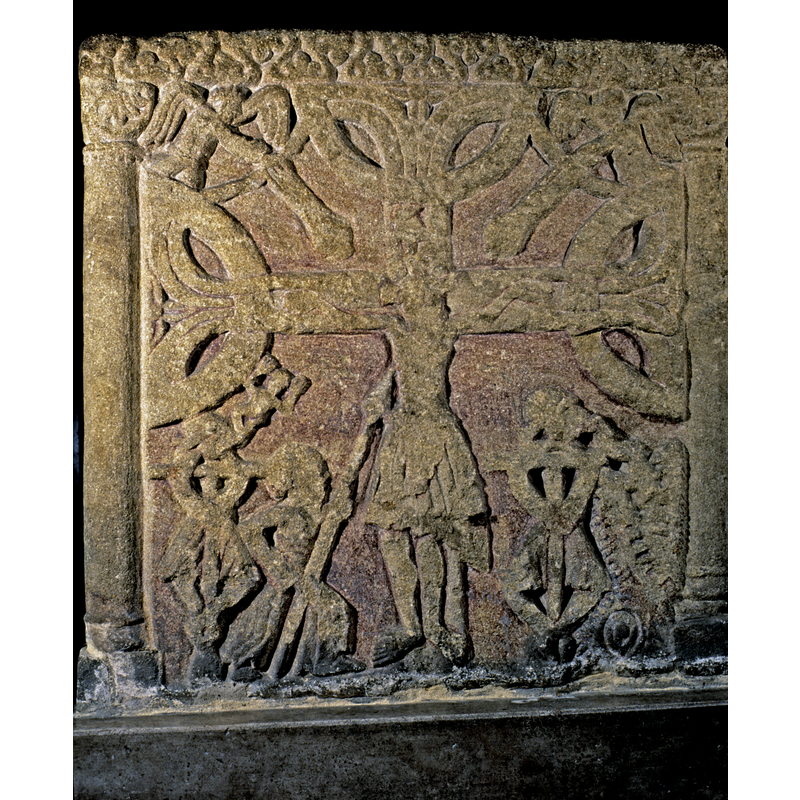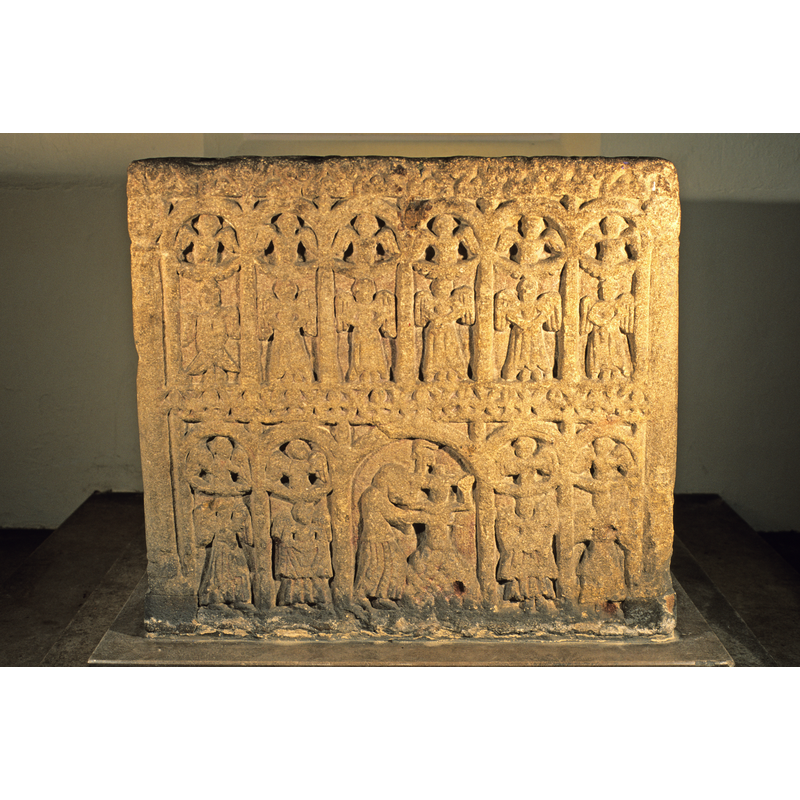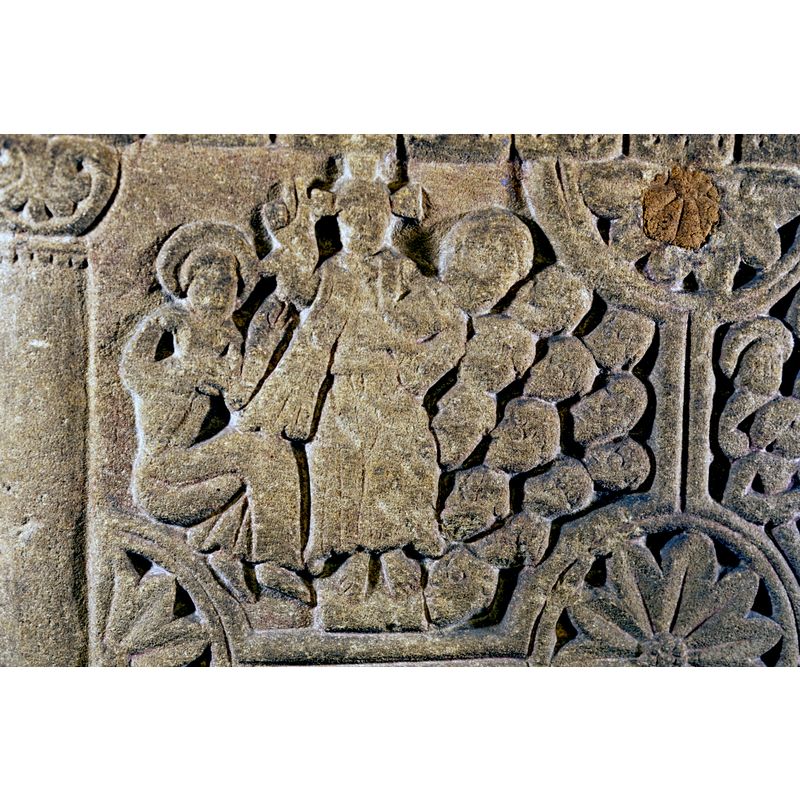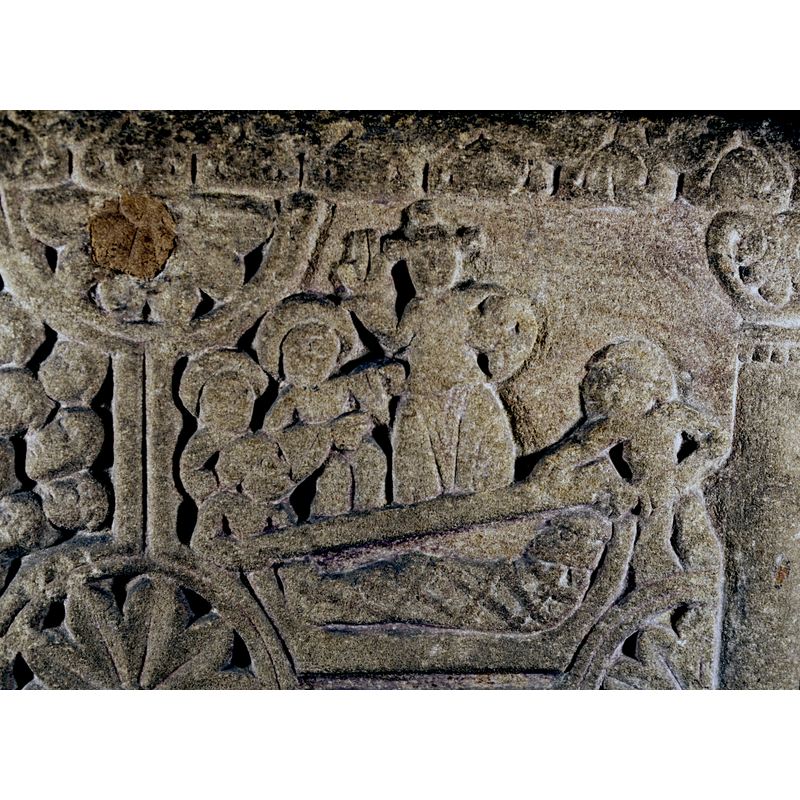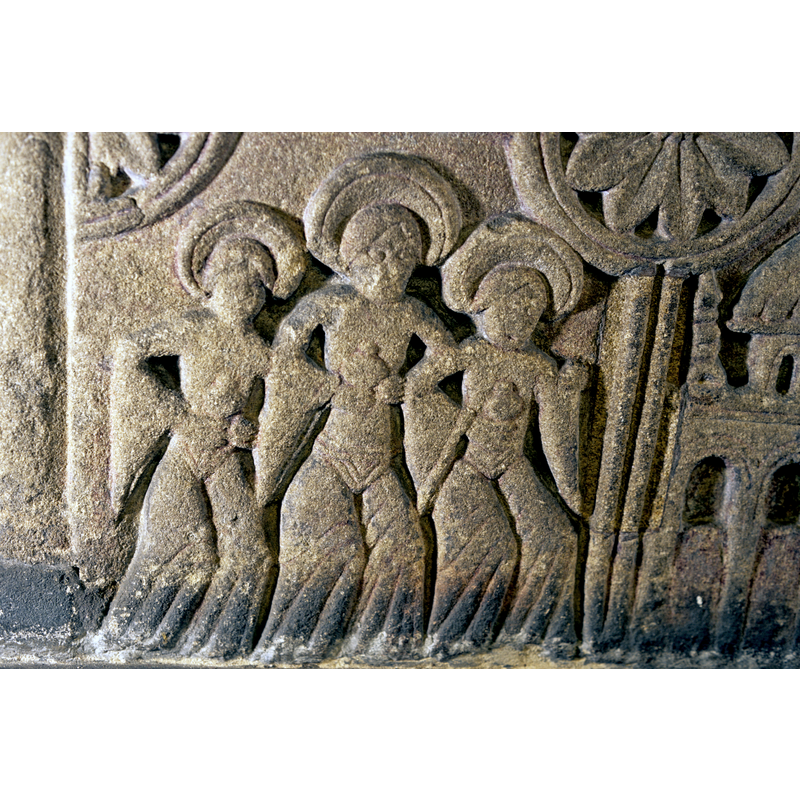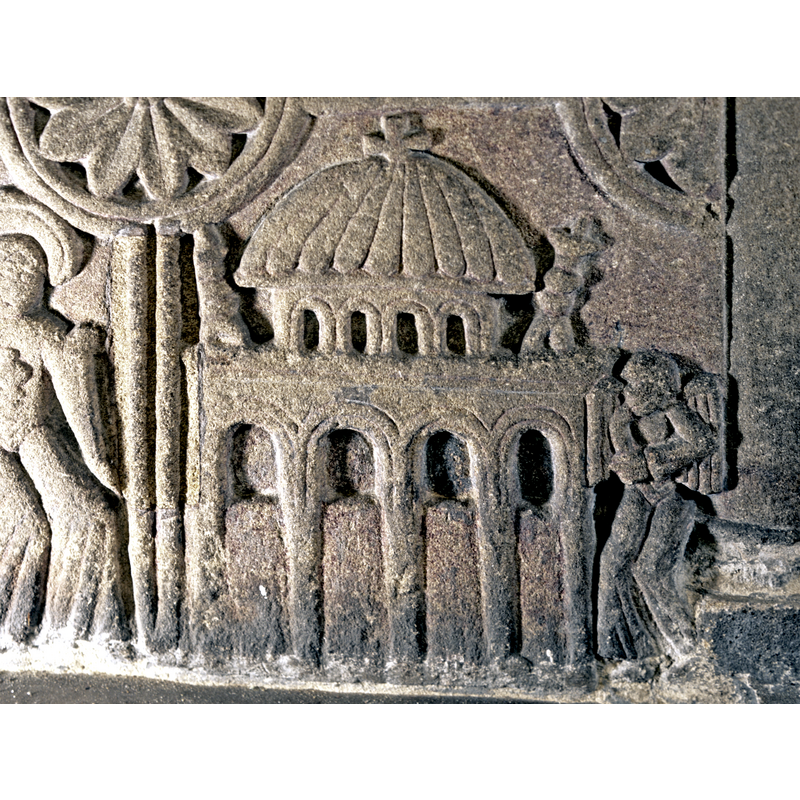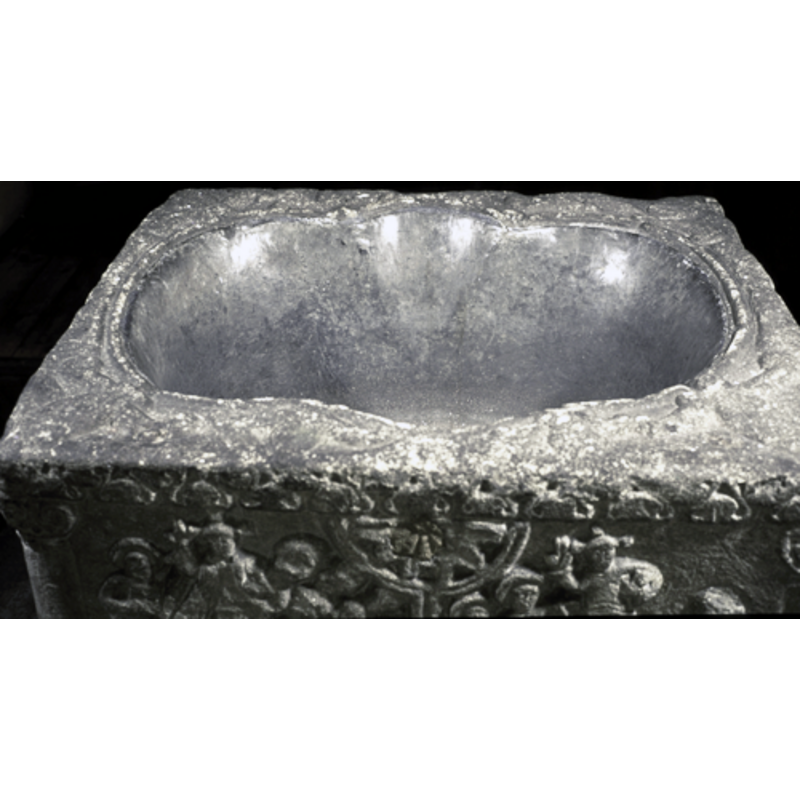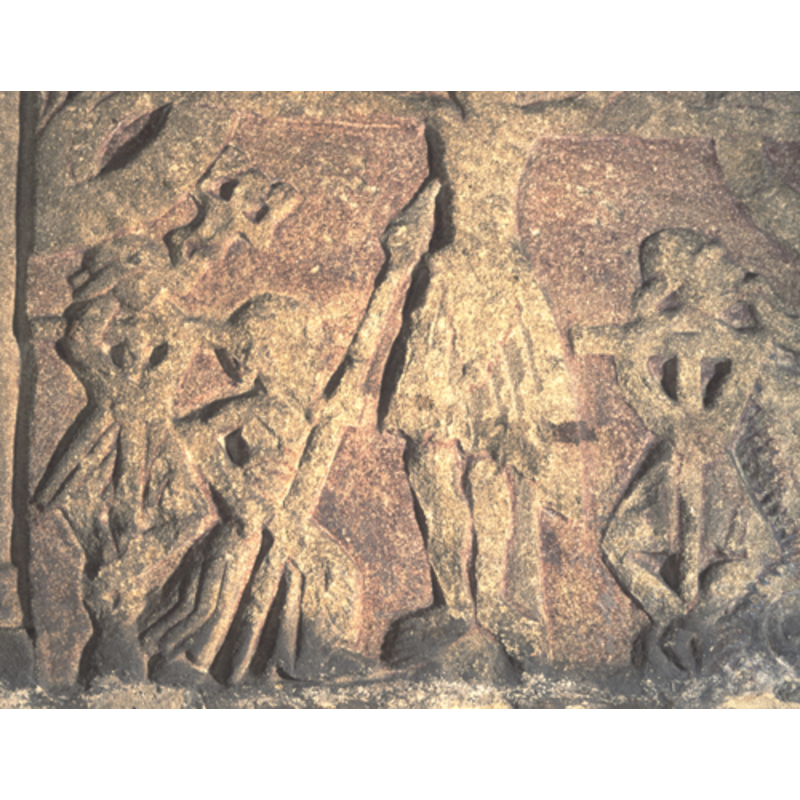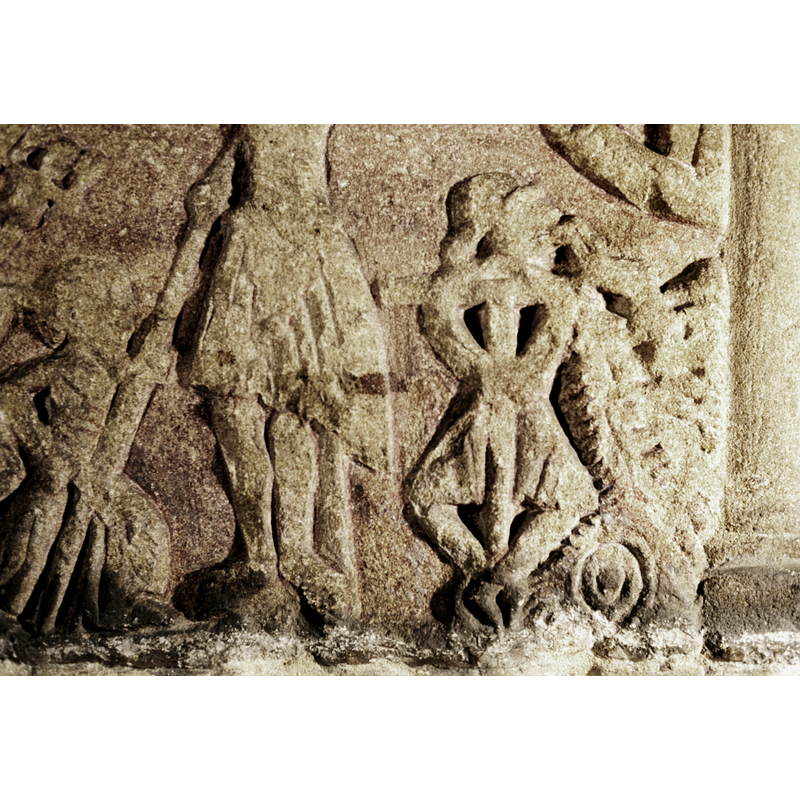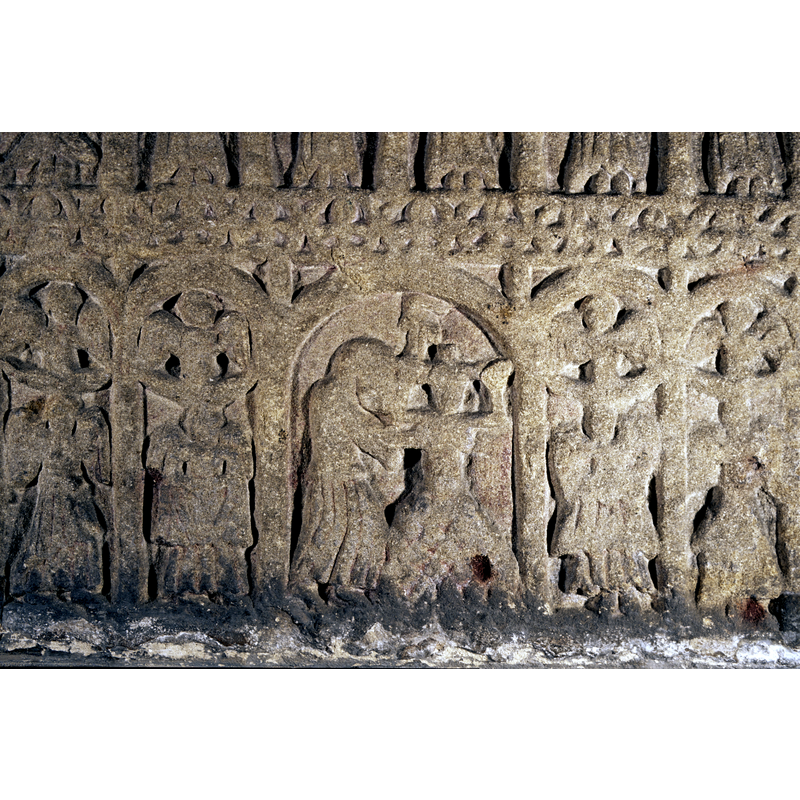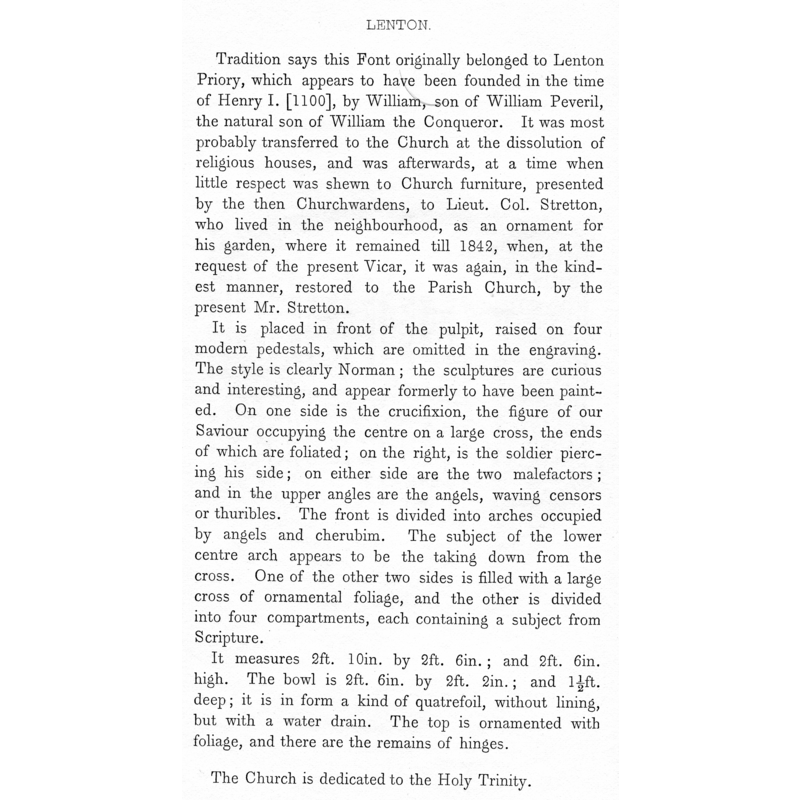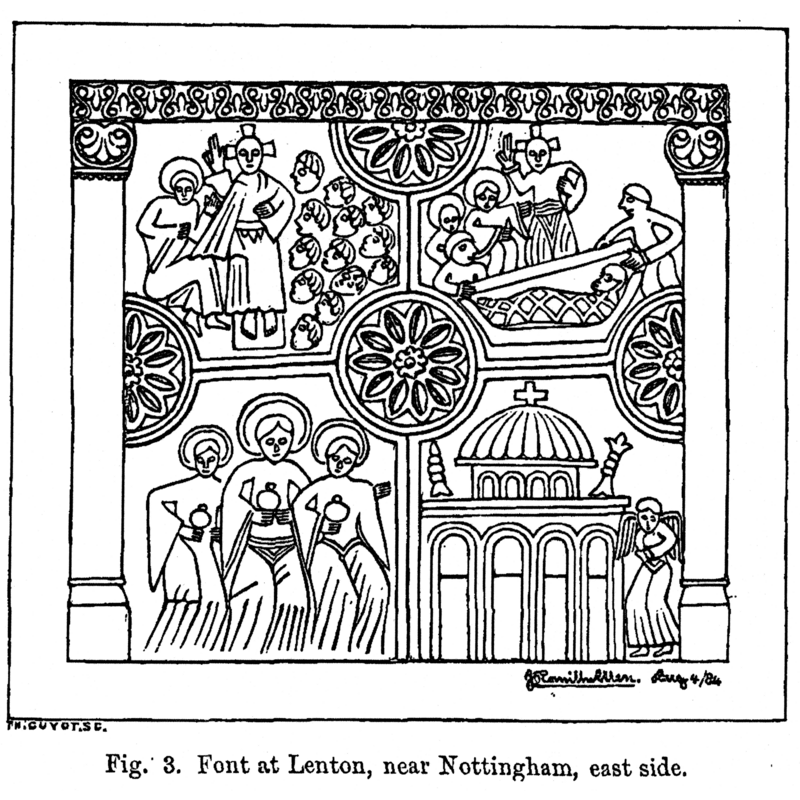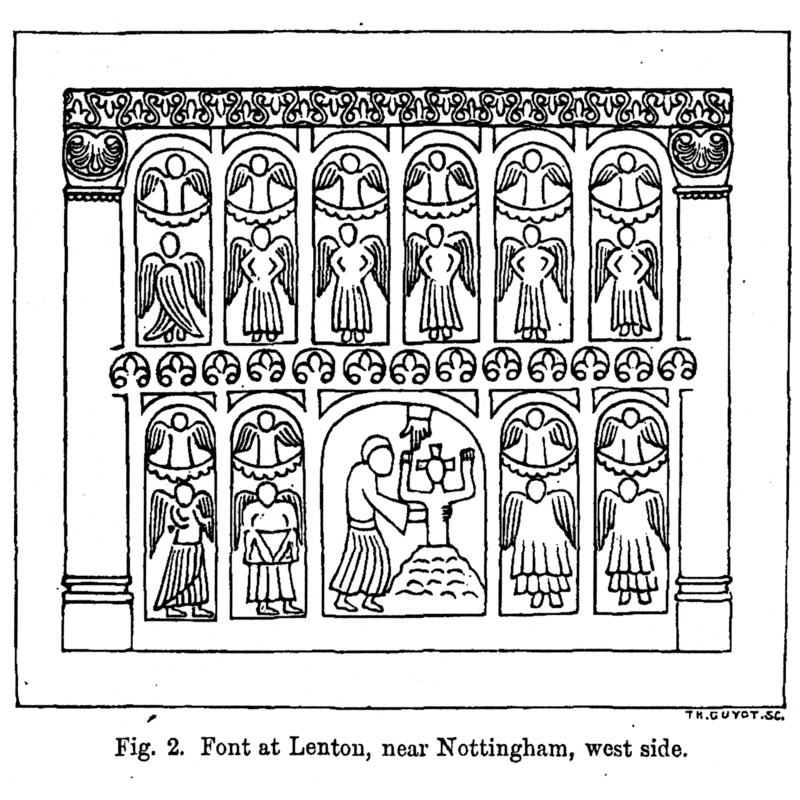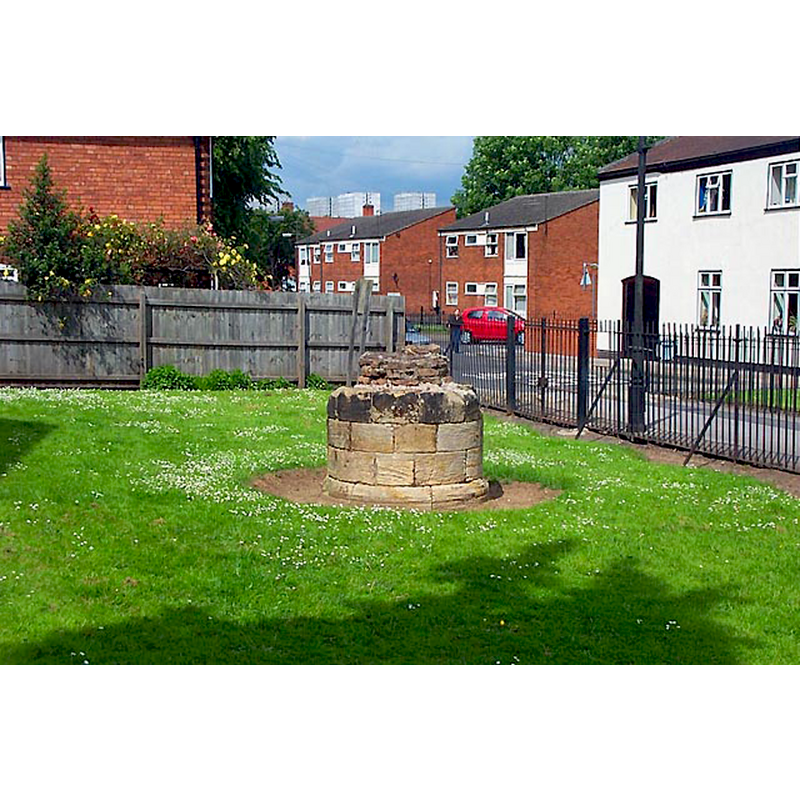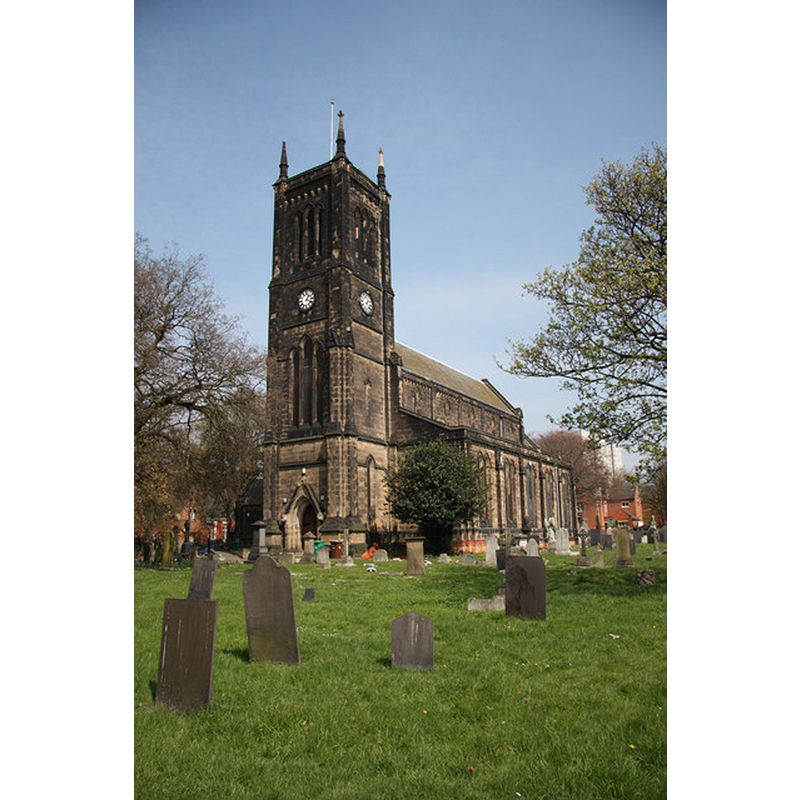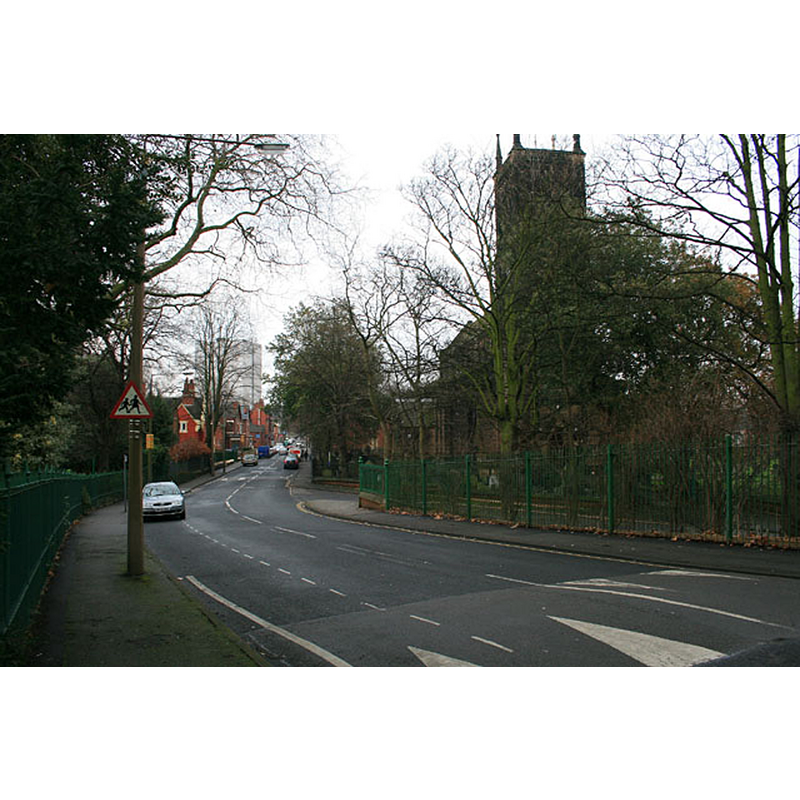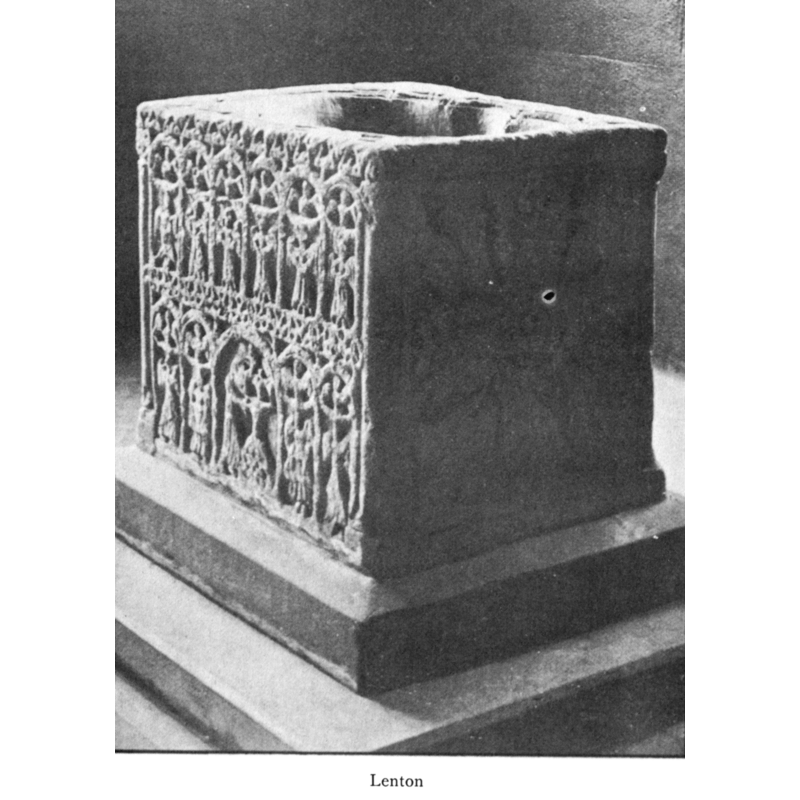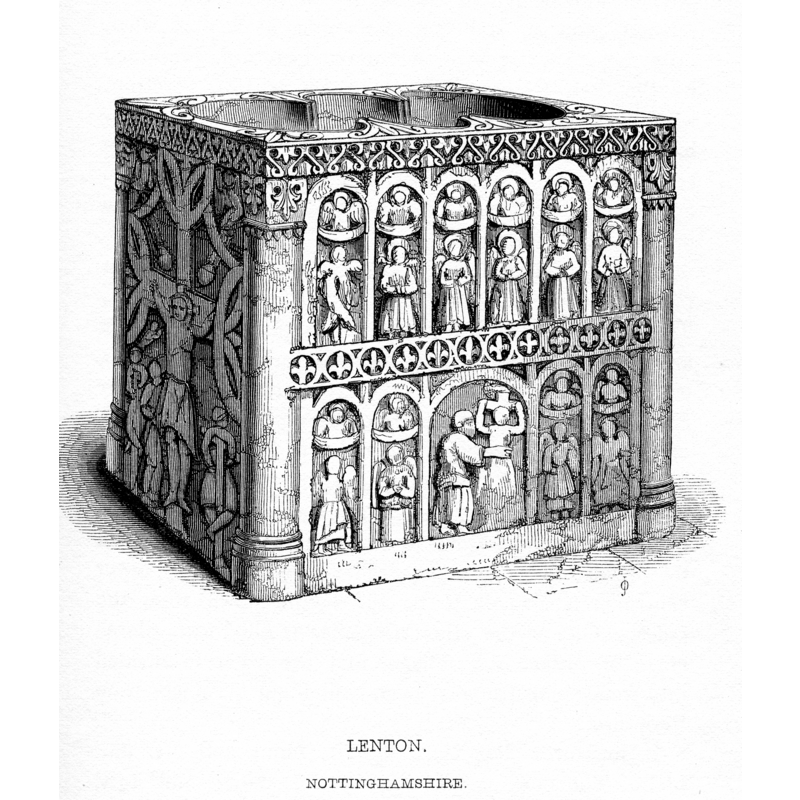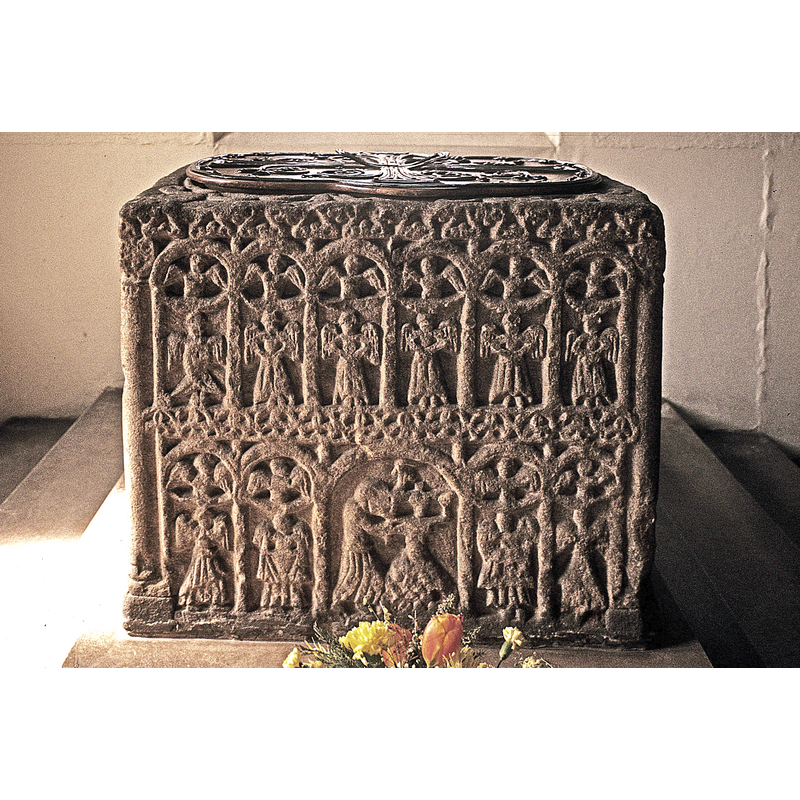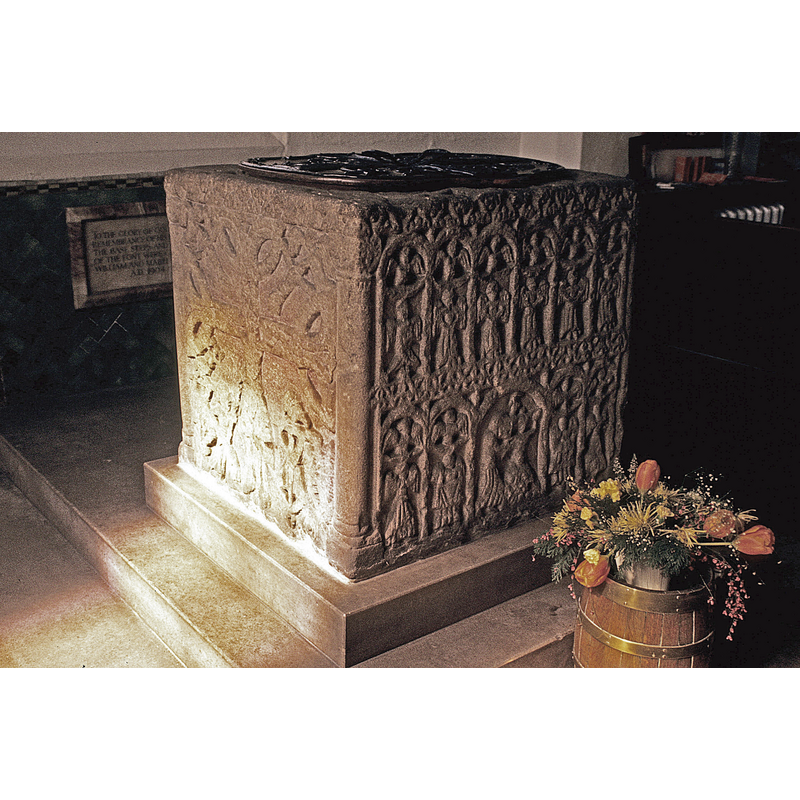Lenton in Nottingham / Lentone / Lentune / New Lenton
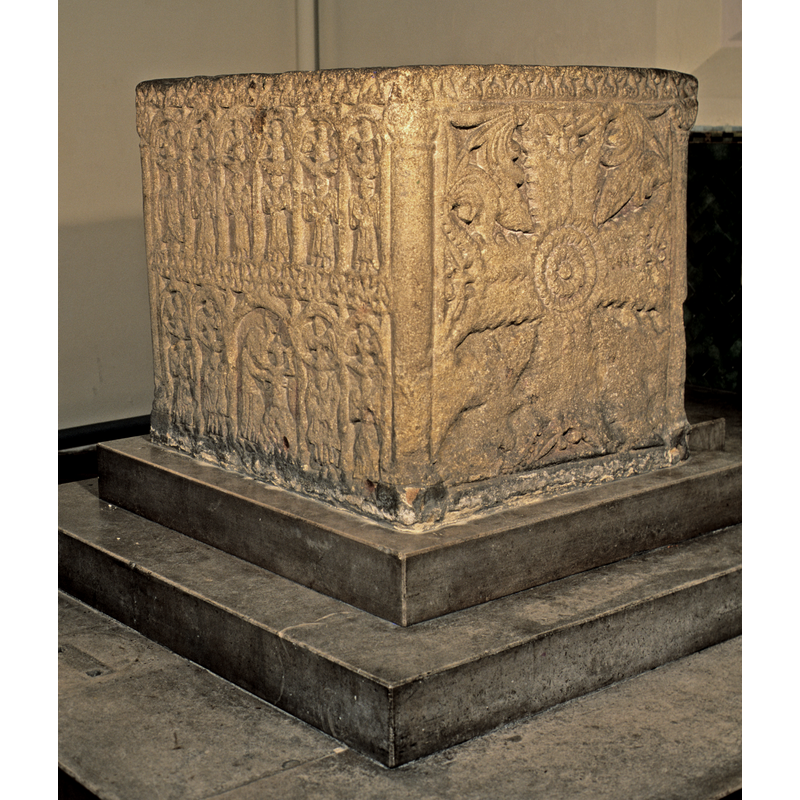
Image copyright © Baptisteria Sacra Index, 2023
Results: 26 records
B01: symbol - cross - with foliage
Scene Description: East side: narrow side: a large cross which covers the whole side; the middle is made of concentric circles, each circle ornamented with zig-zag pattern. Palmettes at the extreme corners
Copyright Statement: Image copyright © Baptisteria Sacra Index, 2023
Image Source: BSI - Photographed 2000
B02: New Testament - Passion of Christ - Crucifixion - Longinus
Scene Description: North side: large cross in the middle with Christ on it; under the arms of the cross appear the two thieves in their crosses plus the two Roman soldiers; at the upper angles, censing angels
Copyright Statement: Image copyright © Baptisteria Sacra Index, 2023
Image Source: BSI - Photographed July 8, 2000
B03: angel - Seraphim - 10
B04: New Testament - public life of Christ - baptism of Christ
B1R01: New Testament - events from Resurrection to Pentecost - Ascension?
B1R02: New Testament - events from Resurrection to Pentecost - Resurrection of Christ - Christ rises from the grave
Scene Description: East side: upper right quarter: Christ standing in the centre of the grave; two haloed figures on the left, one on the right. This scene has been identified by some as the rising of Lazarus
Copyright Statement: Image copyright © Baptisteria Sacra Index, 2023
Image Source: BSI - Photographed 2000
B2R01: New Testament - events from Resurrection to Pentecost - the holy women (the three Maries) on their way to or at the tomb, to anoint Christ's body
B2R02: New Testament - events from Resurrection to Pentecost - tomb of Christ - sepulchre
R01: design element - motifs - floral or foliage
New Testament - Passion of Christ - Crucifixion - Longinus
New Testament - Passion of Christ - Crucifixion - Stephaton
New Testament - public life of Christ - baptism of Christ
information
view of basin - east side
view of basin - north side
view of basin - south side
view of basin - west side
view of basin's top
view of church exterior
Scene Description: Source caption: "Lenton Priory. All that remains of what was once one of the greatest and most important religious houses in the Midlands is the base of a Norman column."
Copyright Statement: Image copyright © Garth Newton, 2002
Image Source: digital photograph taken 4 June 2002 by Garth Newton [www.geograph.org.uk/photo/18657] [accessed 9 November 2014]
Copyright Instructions: CC-BY-SA-2.0
view of church exterior - southwest view
Scene Description: Source caption: "Holy Trinity church. By H.I.Stevens in 1842 including a 12th century font from Lenton Priory"
Copyright Statement: Image copyright © Richard Croft, 2010
Image Source: digital photograph taken 23 April 2010 by Richard Croft [www.geograph.org.uk/photo/1822904] [accessed 9 November 2014]
Copyright Instructions: CC-BY-SA-2.0
view of church exterior in context
Scene Description: Source caption: "Church Street, Lenton. On a grey January lunch-time. That's Holy Trinity Church on the right."
Copyright Statement: Image copyright © David Lally, 2009
Image Source: digital photograph taken 16 January 2009 by David Lally [www.geograph.org.uk/photo/1122312] [accessed 9 November 2014]
Copyright Instructions: CC-BY-SA-2.0
view of font
view of font
view of font
view of font and cover
INFORMATION
FontID: 00200LEN
Object Type: Baptismal Font1
Church/Chapel: Parish Church of the Holy Trinity [formerly in the Priory Church of St. Anthony]
Church Patron Saints: The Holy Trinity
Church Location: Church Street, Lenton, Nottinghamshire, NG7 2FF
Country Name: England
Location: Nottinghamshire, East Midlands
Directions to Site: Lenton is now a suburb of Nottingham. The church is just off the main road/street. The priory church has practically disappeared
Ecclesiastic Region: Diocese of Southwell and Nottingham
Historical Region: Hundred of Broxtowe [in Domesday]
Font Location in Church: Inside the church, at the W end of the nave, S side
Date: ca. 1100-1110
Century and Period: 12th century (early?), Late Norman
Cognate Fonts: Two other English fonts with 'foliated' inner well at Wellow (Som.) and Stafford St Mary's (Staffs.) -- a modern replica of this font in the Cathedral of St Joseph (Dunedin, NZ)
Credit and Acknowledgements: We are grateful to Timothy Marlow for his photographs of this font
Church Notes: priory founded here early-12thC
Font Notes:
Click to view
There are three entries for this Lenton in the Domesday survey [http://domesdaymap.co.uk/place/SK5539/old-lenton/] [accessed 9 November 2014], neither of which mention cleric or church in it. In his brief historical notes on Lenton Priory, Orange (1840) writes: "At what precise period the monastery was totally destroyed, is not known […] but the old material has been used in repairing (probably in erecting) the present church […] the old baptismal font has been removed to the house of one of the former churchwardens, and in its place a stone sprinkling basin has been substituted." Described and illustrated in Paley (1844) with an engraving by O. Jewitt, of Oxford. Noted in Lewis' Dictionary of 1848 as Norman. Described in Poole (1848), with reference to Paley's illustrations. Studied and illustrated (drawings by Théophile Guyot) in Romilly Allen (1884), who suggests that the trio of figures "may be the three Magi, or perhaps the three Marys going to the sepulchre" [cf. infra]. Described in Cox & Harvey (1907) as a baptismal font of the Norman period, one of three English fonts of this period with a foliated basin well interior [the other two are Wellow, in Somerset, and Stafford St. Mary's, in Staffordshire]. Described and illustrated in Bond (1908). Noted and illustrated in Cox (1912), who notes: "The best of many detailed accounts [of the font's programme] is that of Mr. Keyser, Journal of Brit[ish] Arch[aeological] Assoc[iation], vol. xiii. N.S., 238-9." Cox (ibid.) does give a summary description all the same, including a Resurrection and Ascension on the west side, and noting that it is this area of the font that has raised much dispute in the identification of the iconographic programme. Guilford (1927) comments on this [west] side: "The west side is divided into four panels, the interpretation of the subjects carved on them having been much disputed. The upper right-hand panel shows either the Burial and the Resurrection (it was not uncommon to depict two scenes in the same carving), or the Raising of Lazarus, the upper left-hand panel the Ascension, while below the Three Maries and the Church of the Sepulchre are seen." Cox (ibid.) also notes that the Priory served as parish church until 1844. Rectangular Norman font with a basin inner well hollowed out in quatrefoil shape [was this the original shape?]. The top part of the basin sides is ornamented with foliage; angles are carved as round shafts; one of the narrow sides has a Crucifixion, the cross with foliated arms, censing angels at the upper corners and the 'Manus Dei' appears just above Jesus' cruciform nimbus; the two thieves hang on smaller crosses, the soul of the good thief going up to heaven, while the soul of the evil thief plunges towards a hell represented as the mouth of a ravenous serpent; on the opposite side, a large foliated cross; one of the two larger sides is divided into four compartments by a cross: the two upper ones contain the raising of Lazarus with Jesus, Martha, Mary, Lazarus himself and a crowd of onlookers; the lower compartments depict the Three Marys at the Sepulchre. The front side of the font is divided into eleven parts by arches: six up and five down, the middle of the latter containing the Baptism of Jesus who stands in water up to his middle with hands uplifted in prayer, the 'Manus Dei' appearing from the clouds, while John the Baptist holds Jesus by the wrist; angels and other figures fill the other compartments. On-site notes: the font stands now [July 2000] on a plain two-step plinth. Paley (1844) reported it "in front of the pulpit, raised on four modern pedestals, which are omitted in the engraving". The font is illustrated and its colourful history documented in the Parish website [www.lentonparish.org.uk/history/font.html] [accessed 9 December 2009]: "When the pulpit was removed to the north side of the Chancel, there was left a font standing in front of the reading desk. This font was removed and put on a stone plinth near the west door, but in 1904 it was again removed to its present position. This Norman font, dating back to around the year 1100, undoubtedly belonged to the Great Priory of Lenton, and thus in the present Church it constitutes the one binding link between the modern Parish Church and the old. It was in the possession of the Stretton family but reclaimed when the new Parish Church was being built. Meanwhile it had been used as a flower bowl in Colonel Stretton's garden. Colonel Stretton had built and lived in the house which is now occupied by the Sisters of Nazareth in the Nazareth House complex. The Reverend George Browne, the vicar, related in his parish magazine the story of its restoration to the Church: He was being shown round the garden of Colonel Stretton, by Brownlow the old parish clerk when he noticed the font in use as a garden decoration, covered with weeds and filled with rubbish. Said the vicar to Brownlow, "That is a strange object. is it part of the old ruins? What purpose did it serve with the Friars of old times? Was it their punch bowl?". Brownlow replied "That is the baptism font that was years agone in that ere church" pointing to the poor tumbling down fabric of the old Parish Church. Vicar said "And how came it there?" "Oh?" replied the old clerk, laughing, "the churchwardens made a present of it to Master Stretton." The Reverend Browne wrote to Colonel Stretton requesting its return, and he consented. It stood in the Priory churchyard, used as an umbrella stand, until it was removed to the new Parish Church. It was in 1904, through the generosity of Mr. W.G. Player, that the font was erected in its present position, suitably mounted on base steps of marble and oak, and fitted with an oak and wrought iron decorated cover. At the same time the wall behind the font was tiled in the same style as the present reredos and a tablet bears the following inscription: 'To the Glory of God and in remembrance of his mercies, the base steps and cover of the font were given by William and Mabel Player. A.D.1904.' The bowl of the font is 30 inches by 26 inches by 18 inches deep and evidently was intended for the practice of immersion. It is richly carved on all sides. Although much worn by the ravages of time, the carvings are discernable […] On the north side there is an elaborately decorated cross. On the South side there is a remarkable portrayal of the Crucifixion. The central Cross occupied by Christ is much larger than the other two. The Roman soldier is piercing Christ's side with his spear. On the side now facing east, there is carved at the top a row of cherubim, under them a row of Seraphim, and beneath, all the four Evangelists, and a central panel depicting the Baptism of Christ by John. On the West side are four panels: [1] the first represents the resurrection of Christ who holds up his hand in blessing. The angel is sitting upon the stone which has been rolled away from the mouth of the Sepulchre. [2] In the second panel we have a strangely combined view of the entombment and resurrection. A brutal looking Roman soldier is putting on the coffin lid underneath which lies the swathed figure of the Crucified, while Christ himself, with hands uplifted in blessing, stands above. Two angels are seen seated on the left. [3] The third panel shows the three women coming on the first Easter morn to the Sepulchre, bearing in their hands spices and ointments. [4] The fourth panel gives a view of the Holy Sepulchre guarded by an angel seated on the right. This portrayal of the Sepulchre as it existed before the Crusades would seem to suggest that the font was carved by some person who had visited the Holy Land. In Torrens Alzu (2010). A communication from Michael Czajkowski, a geologist who visited the font, identifies the stone of the font as calcareous sandstone [email of 26 June 2012].
COORDINATES
Church Latitude & Longitude Decimal: 52.948227, -1.1762
Church Latitude & Longitude DMS: 52° 56′ 53.62″ N, 1° 10′ 34.32″ W
UTM: 30U 622537 5868068
MEDIUM AND MEASUREMENTS
Material: stone, sandstone (calcareous sandstone)
Number of Pieces: one
Font Shape: rectangular (unmounted)
Basin Interior Shape: quatrefoil
Basin Exterior Shape: rectangular
Drainage Notes: lead-lined
Rim Thickness: 5-24 cm (min.&max. of the quatrefoil shape)
Diameter (inside rim): 49 x 72 cm (diagonals)
Basin Depth: 36 cm
Height of Basin Side: 75-76 cm
Basin Total Height: 75-76 cm
Font Height (less Plinth): 76 cm
Trapezoidal Basin: 85 x 73-75 cm
Notes on Measurements: BSI on site [a set of measurements in feet and inches can be found in Paley (1844) and in Cox (1912)]
LID INFORMATION
Date: ca.1904
Material: wood and metal
Notes: [cf. FontNotes
REFERENCES
Allen, J. Romilly, "Notes on Early Christian Symbolism", N.S., VI, Proceedings of the Society of Antiquaries of Scotland, 1884, pp. 380-464; p. 408, 420fn2, 420fn3, 420fn7, 428 and fig. 1-3
Boase, T., English Art 1100-1216, Oxford: Clarendon Press, 1953
Bond, Francis, Fonts and Font Covers, London: Waterstone, 1985 c1908
Clapham, Alfred William, English Romanesque Architecture after the Conquest, Oxford: Clarendon Press, 1934
Cox, John Charles, English Church Furniture, New York: E.P. Dutton & Co., 1907
Cox, John Charles, Nottinghamshire, London: Allen, 1912
Friar, Stephen, The Sutton Companion to Churches, Thrupp, Stroud (Gloucs.): Sutton Publishing, 2003
Guilford, Everard Leaver, Nottinghamshire, London: Methuen, 1927
Kroesen, Justin E.A., The Interior of the medieval village church = Het middeleeuwse Dorpskerkinterieur, Leuven: Uitgeverij Peeters, 2004
Lewis, Samuel, A Topographical Dictionary of England, Comprising the Several Counties, Cities, Boroughs, Corporate and Market Towns, Parishes, Chapelries, and Townships, and the Islands of Guernsy, Jersey, and Man, with Historical and Statistical Descriptions [...], London: S. Lewis, 1831
Moule, Thomas, The English counties delineated; or, A topographical description of England [...], London: George Virtue, 1837 [vol. 2]
Paley, Frederick Apthorp, Illustrations of Baptismal Fonts, London, UK: John van Voorst, 1844
Pevsner, Nikolaus, Nottinghamshire, Harmondsworth: Penguin Books, 1979
Poole, George Ayliffe, A History of Ecclesiastical Architecture in England, London: Printed by Joseph Masters, 1848
Stocker, D.A., "Fons et origo: The Symbolic Death and Resurrection of English Font Stones", I (1997b), Church Archaeology, 1997, pp. 17-25; p. 18
Torrens Alzu, Miguel A., "Del Domesday Book a los suburbios de Nottingham: historia y descripción de la pila bautismal del Priorato de Lenton", 11 (Diciembre 2010), Románico: revista de arte de Amigos del Románico, 2010, pp. 52-58; p. 52-58
Wadmore, J.A.W., Collections for a parochial history of Barrow Gurney, Bristol: Lavars and Co., 1897

